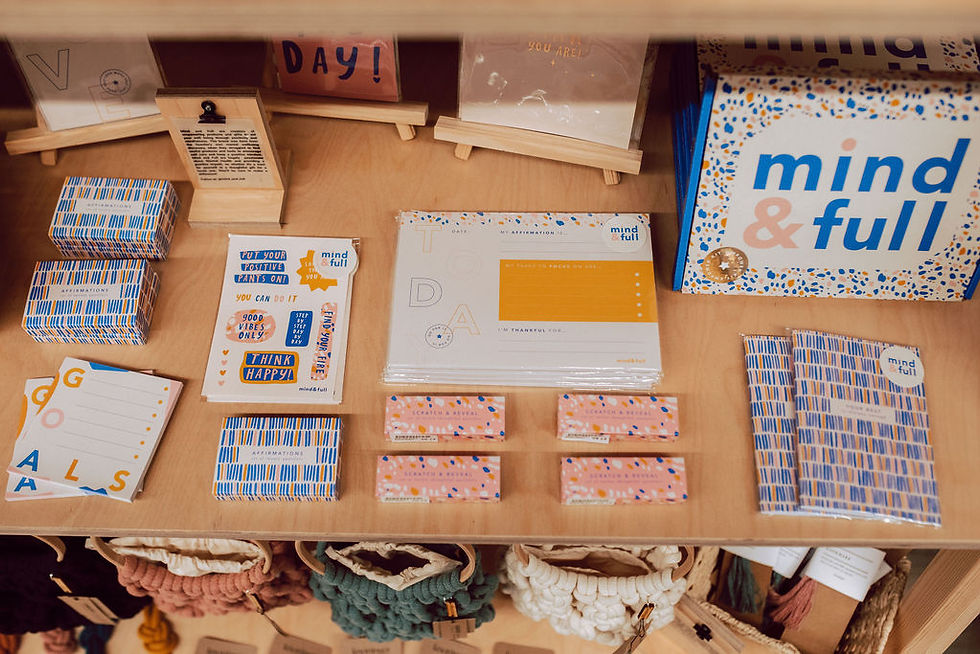HOW TO KNOW IF YOU ARE RETAIL READY
- John Shepperd

- Jun 12, 2023
- 9 min read
Updated: Jan 26, 2024

Hello! Megan here, founder of Curated Makers. This has been a long-anticipated blog post... I’ve been thinking about it for ages, questioning what to include, and what questions do I find myself answering and explaining to makers quite often. And really, what golden nuggets of information would really help a business when it comes to taking that next big step into the world of third party retailers and stockists...
So here's my stab at it, it may not be the perfect guide, but it's definitely a starting point. See it as a discussion starter, and a useful tool I hope for certain small businesses on their journey of navigating working with shops, galleries, and pop-ups and starting to embark on wholesaling and commission-based opportunities, to grow their brands further than you can do alone.
Firstly, growth isn’t for everyone!
And that’s OK! I’ve come across many small business owners over the past few years, trying to keep below that dreaded VAT threshold because of the admin it brings with it, and I get it!
Hitting the £80k-ish turnover mark may sound impressive, but that’s turnover, not profit don't forget. Once you hit these numbers, it’s likely you’ve got very high costs behind the scenes, perhaps even other people working with you, which also comes at a cost.
Now, something I’ve learnt is that to make money, you have to spend money! There is no quick fix here, growth comes with a cost and a risk factor that you have to be comfortable with.
If you don’t want to grow bigger than the threshold, then I applaud you for knowing what you want. Go for it, stick to your guns and good luck teetering on the edge, I bet that’s hard work to having to make difficult decisions and possibly even turning down work, but that’s all in the pursuit of good work/life balance.
So please know I appreciate that a lot and if I was a maker myself, it would be a big consideration for me too.

If you do want to pursue growth via stockists, ensure you have the margin to do so!
To work with shops, galleries and so on, you need to ensure your products are profitable for both you and the third party seller that you’re selling through.
More often than not, third party sellers are not greedy. They have very high costs of their own that need covering…as well as that dreaded 20% VAT I mentioned earlier that they'll need to add onto their services.

When you have to charge VAT as a company, as we do on our commission, that money is solely for the VAT Man! The Company becomes a vehicle for the VAT Man, to collect VAT on the products and services sold on their behalf. So this money will never go to the Company itself, it’s not profit, it’s not fun money - the Company is acting as a tax collector for the VAT Man, with no payment for doing so. If you ask me, the threshold is FAR TOO LOW…it should be higher as like I said, turnover does not equate to profit!
Someone once said to me that if you’re paying a lot of tax it can only mean you’re making money, so never see it as a bad thing eh! I always like to find the positive in situations so there it is. If you’re paying tax, you’re making money!
So, bearing this in mind, let's talk about margin and how to improve them…
Suppliers
What can you do to renegotiate with your suppliers for a better rate? Are you aware of what the volumes are when you start to get a lower rate?
Have you looked at alternative suppliers recently? You can get comfortable with the ones you use for ease, but are they still the best fit for you? Has anyone else come up in the meantime since you found them? Always keep your eyes peeled as this can help your negotiations.
Reassess your Product Range
Are there certain products that just don’t work for wholesale margins? Perhaps. So which ones do work? Know each line and the profit it makes you. Keep those that don’t commercially work for stockists, for your markets, online, or own platforms. Those that you have more wiggle room with, use those for wholesaling. It’s fine to do that, you get the benefits of growing your brand further through third parties, retain the profits you need, and hopefully get those customers back when they return to you directly and buy more from you when they see your full range.
Other Costs
Have a look at your costs - they may be high in areas that you don’t need anymore. Have outgrown certain services that you’re paying for and don’t need? Are you utilising all of your tax efficiencies and have you spoken to an accountant for some advice?
Also, be mindful of the retailer's costs too; their rent, rates, shop staffing, insurance, training, setup costs, fixtures fittings, VAT... By working with a 3rd party retailer, you get access to all of this without having to spend any £££. This is what they charge their prices for, and then hope there’s some profit left to make it all worth it.
Pricing
Are you charging enough? Pricing products is HARD and there’s no right answer. But think about how Primark charge what they do, compared to Burberry. How Vauxhall differs from Tesla. Cava differs in price from Champagne. Aldi and Waitrose. They are an amalgamation of costs yes…but mainly perceived value, branding, quality, volume and exclusivity vs. mass market and accessibility.
Where do you want your brand and products to sit on the scale? Only you can figure that out and it may well take some trial and error! Lots of it I bet. We’re still learning too….flat rate fee, commission rate, split of both, enough or too much?! We’ll always be reviewing our own structure too and I advise you to always review it too.

Test out something new…and it’s OK to change your mind.
A little on the point I’ve just made. You can change your mind, make it up, test, learn fast, improve…continuously!
How can you compare two completely different brands, with two completely different people standing behind that market stall, with different techniques of selling, different products, and different price points? It all depends on who walks through that door at the end of the day, some of it is pure luck, some of it is tactical, but you’ll never know if you don’t try!
So get out there, test your own way, go against the curve, follow the tips you read, make up your own theories and test them, reflect and review, and continue to develop and learn.
It’s full-on this business life isn’t it…but it’s never dull!
Do your products work on the shop floor?
We found a beautiful fudge brand we wanted to stock in our pop-ups, but when we reached out to them, we found out they don’t offer them individually wrapped like we would need them to be on the shop floor. Do you make the decision to adapt and make it retail-ready, or do you stick by your guns and just look for markets where you can sell it open? Maybe consider it for the future and not right now, but do consider it.
When it comes to jewellery there are tons of decisions to be made for displaying your work for the shop floor; big boxes, small boxes, in glass tubes, on backing cards, backing cards with a hole in for handing?! Also, make sure that you think about the size of the packaging and how many will sit on the shelf or fixture. Stockists will assess how 'shoppable' your products are and how they work within the layout of their store.
This could / will dictate how many you sell! I don’t have the magic answer to share with you here, but I know it is a big decision. What works for one shop may not work for another. What works at a trade show may not work at the market. Do your homework on the types of retailers you would like to stock with and consider how you can adapt your display and packaging to make your product sellable and to make the shopkeeper's life easy too.

Play ball and keep in touch with your contacts
As a retailer, we struggle if we don’t hear back from emails and if we don’t get responses to top-up requests from our makers, and so on. Communicating to 50+ makers per pop-up is no mean feat. The success of the pop-up works best as a team effort between retailer and makers. When our makers are involved, responsive, polite, keen and active! It makes such a difference and also shows in sales too. So my advice is to be on top of your communications, as non-creative as it is, it is a major part of success when it comes to working with 3rd parties.
Relationship building is priceless and half the time you only have to be yourself, be nice and be open-minded. Oh and always try to be positive, it helps me so much! If something doesn’t go quite right, it’s a learning opportunity surely?! Don’t get defensive, this is business, it’s never personal. Getting bogged down is hard to bounce back from, so try to spin situations and then into learning opportunities with an open mind and I promise you, you’ll feel a weight lifted from your shoulders with a positive outlook.
Remember you can't stock everywhere and be everyone's cup of tea!
When choosing which retailers you would like to work with, keep the following in mind:
Different shops have different target audiences + every location has differing demographics - who are you trying to sell to?
Footfall varies so much from small quirky shopping streets to out-of-town shopping centres, to city centre high streets - where is your customer shopping?
Every shop only has a limited amount of space and its own planned curations - where does your product fit?
There are SO many variables to consider. Don't be disheartened if it's a no from your dream stockist, it'll be a commercial decision based on them knowing their customer base and current product range. They don't want to waste your time, or precious stock, as well as not want products on their shelves that they don't believe resonate with their customers, as they need them to sell to survive!
Not every shop can stock the same products. That would make for pretty boring shopping wouldn't it! Look at those High-Street giants that have failed of late, with repetitive brands on every high-street. Remember, your work isn't right for every shop, that's OK. Take the time to find the shops that are the perfect match...focus on quality over quantity would be my advice. Who do you want your brand to align with? Which shops make you feel super proud to be a part of? If you're in too many shops...could that be a disadvantage?! Take the time to find your crowd.
Personally, I may see a maker I love but think that they won't be right for a certain event based on their price point, their niche, their colour-ways, the product size based on the amount of space I have available on the fixtures. It's all based on history, based on previous experience, sometimes it's a gut reaction. But I always try to think if not this event, where else?! You may not be suited to our Trinity Leeds store, but you may be perfect for our Cheadle John Lewis Pop-Ups.
So if you don't hear from us, it may well be we have you earmarked for a different event in the future. Sadly we can't reply to everyone to let them know, I wish we could, but it's impossible due to demand. But please know, that we love social media and keep our eyes peeled for who is doing what, new product lines, and who is engaging with us and we enjoy seeing your progress and cheer-leading you from afar!

Take advice...but also just go with your gut!
Now I’ve chatted on from my personal opinion for 6 big points above. They’re my opinions, they’re not gold dust. So take the info you want, act on it where you see fit, but leave the rest that doesn’t serve you. I get ‘advice’ all the time but I chose what to really listen to, absorb the nuggets but leave the rest and understand that the majority of the time going with your gut is the right thing to do. It’s a second brain your gut, it’s a powerful tool, so use it. Alright, it may not always be right, but again, seek the positive and feel proud you were bold!
When I was first building Curated Makers, I’d sign up for all the free courses I could and could fit into my schedule. I’d be bombarded with advice, tips, and tricks…but you can’t do it all! I’d say half of it was just common sense or stating the obvious, but there were nuggets I took in among the jargon. There were points that reinforced what I already knew which helped my confidence. I met and spoke to people I would have never usually met, I was inspired by their grit and their determination which fueled me further.
So go to the course, meet the people, absorb what you can and always know you never know it all! Continue to adapt and develop, enjoy the ride and learn as much as you can along the way!
I’ve tapped away here sharing my thoughts, but I’d love to hear what you think?! Are these things you've thought about before? Is there anything else you think makers need to consider? I'll share a post onto the grid and I welcome your feedback and comments on that to help take the conversation further.
Speak soon,
Megan x
Feel your brand is retail ready?! You can register your interest in popping up with us at
We have made a useful guide too to help you when registering, I really hope it helps!
PS. If you have already registered your interest on our website, there is no need to do this again! We have you logged on our database and will be in touch if we feel the right opportunity has come up that we think you'd be a good match for.
